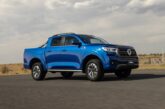
Dan Powell of Honest John Vans tells you what to look out for when buying a second-hand Ford Ranger pick-up.
Easy to drive, comfortable and boasting genuine go anywhere potential, the Ford Ranger sets a benchmark by which many other pick-up trucks are judged. The Ranger was given a comprehensive overhaul in 2015 and carrying capacities exceed one-tonne on all models, while the towing capability is as much as 3,500kg with a braked trailer.
What to pay
You’ll do well to find many Rangers in the sub-£10,000 bracket. Those that are here are typically early single-cab models, in base trim that have been bought to work and wear the mileages to prove that. Don’t be frightened of them, as big mileages from business vehicles tends to suggest they’ve been looked after, just be sure to make sure it comes with a wad of receipts to demonstrate that it’s been looked after properly.
£15,000-£18,000 is rich-pickings for a Ranger buyer. Here you can really afford to shop around, with everything available in this price bracket. You’ll get a pre-facelift two-year old Ranger with under 20,000 miles here, or post-facelift version with higher miles. In all price segment it’s the 2.2-litre engine that makes up the bulk of the choice, make sure you know which output you’re getting as the lower power one can feel a touch overwhelmed when fully laden.
If you want the bigger engines then spend £20,000 or more, with this price point seeing a glut of choice of 3.2-litre examples, most coming with fully-loaded specifications. Above that and you’re into the nearly new, ex-demo stock, where you can bargain hard from the dealers you’ll likely be buying them from.
Engines
At its 2011 launch the Ranger was fitted with a choice of two diesel engines with a choice of outputs. The entry-level choice was a 2.2-litre TDCI turbodiesel four-cylinder with 135PS and 320Nm of torque. A more powerful version of the same basic engine was offered with 150PS, and a boost in torque to 375Nm. Above the four-cylinder engines Ford offers the Ranger with an in-line five-cylinder turbodiesel, it having 200PS and 470Nm of torque, the larger engine only offered mated to four-wheel drive.
The output of the range-topping five-cylinder 3.2-litre engine remained at 200PS, with the entry-level 2.2-litre dropping to 130PS and the higher power version rising to 160PS. The newer engines brought significant gains in economy over the earlier ones, bringing down day-to-day running costs.
What to look out for
As with any four-wheel drive commercial vehicle, have a good look underneath for any damage due to off-road scuffs and knocks. It’s worth checking the rear driveshafts, too, as the gearshift cables can contact them, leading to loss of drive – this was the subject of a recall of vehicles built between November 2015 and February 2016.
Any sluggishness of response and high fuel economy might be related to the mass airflow sensor. It’s a common fault on the Ranger, which can also manifest as making starting difficult. Check the quality and ease of the gearshift too – if it’s been abused or used to tow a lot it can cause excessive wear, making gear selection difficult or noisy.
Listen for any rattling from the engine and don’t ignore it; the Ranger has had issues with its oil pump, losing pressure and ultimately failing. If it does so you could seize the engine. The engine check dash light should also illuminate, if it does have it checked, immediately. Euro6 models from 2016 onwards may have problems with their selective catalytic reduction system, which results in excessive consumption of AdBlue. An engine check light will glow too.
A 2018 recall relating to the automatic transmission relating to early models from September 2011 through to March 2012 noted the gearbox may receive an incorrect signal, changing from sixth to first. If you buy an early automatic, make sure this has been investigated.







